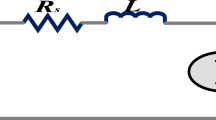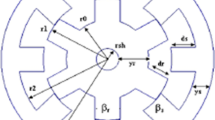Abstract
This paper proposes a speed control of switched reluctance motor supplied by photovoltaic system. The proposed design of the speed controller is formulated as an optimization problem. Ant colony optimization (ACO) algorithm is employed to search for the optimal proportional integral (PI) parameters of the proposed controller by minimizing the time domain objective function. The behavior of the proposed ACO has been estimated with the behavior of genetic algorithm (GA) in order to prove the superior efficiency of the proposed ACO in tuning PI controller over GA. Also, the behavior of the proposed controller has been estimated with respect to the change of load torque, variable reference speed, ambient temperature and radiation. Simulation results confirm the better behavior of the optimized PI controller based on ACO compared with optimized PI controller based on GA over a wide range of operating conditions.














Similar content being viewed by others
Abbreviations
- N r and N s :
-
Number of rotor and stator poles, respectively
- q :
-
Number of phases
- C r :
-
The commutation ratio
- β s and β r :
-
The stator and rotor pole arc, respectively
- I and V :
-
Module output current and voltage
- I c and V c :
-
Cell output current and voltage
- I ph and V ph :
-
The light generation current and voltage
- I s :
-
Cell reverse saturation current
- I sc :
-
The short circuit current
- I o :
-
The reverse saturation current
- R s :
-
The module series resistance
- T :
-
Cell temperature
- K :
-
Boltzmann’s constant
- q o :
-
Electronic charge
- KT :
-
(0.0017 A/°C) Short circuit current temperature coefficient
- G :
-
Solar illumination in W/m2
- E g :
-
Band gap energy for silicon
- A :
-
Ideality factor
- T r :
-
Reference temperature
- I or :
-
Cell rating saturation current at T r
- n s :
-
Series-connected solar cells
- k i :
-
Cell temperature coefficient
- k :
-
The duty cycle of the pulse width modulation (PWM)
- V B and I B :
-
The output converter voltage and current, respectively
- J t :
-
The objective function
- K P and K i :
-
The parameters of PI controller
- n :
-
Number of nodes
- m :
-
Number of ants
- t max :
-
Maximum iteration
- d max :
-
Maximum distance for each ant’s tour
- β :
-
The relative importance of pheromone versus distance (β > 0)
- ρ :
-
Heuristically defined coefficient (0 < ρ < 1)
- α :
-
Pheromone decay parameter (0 < α < 1)
- q a :
-
Parameter of the algorithm (0 < q a < 1)
- τ o :
-
Initial pheromone level
- d i :
-
Distance between two nodes
- u :
-
Unvisited node
- r :
-
Current node
- τ ij :
-
The pheromone trial deposited between node i and j by ant k
- η ij :
-
The visibility and it equals to the inverse of the distance (η ij = 1/d ij )
- T k :
-
The path effectuated by the ant k at a given time
References
Krishnan R (2001) Switched reluctance motor drives. modeling, simulation, analysis, design and applications. CRC Press, Boca Raton
Veltman A, Pulle DWJ, Doncker RD (2007) Fundamentals of electrical drives. Springer, Berlin. ISBN 978-1-4020-5503-4
Gieras JF (2009) Advancements in electric machines. Springer, Berlin. ISBN 978-1-4020-9006-6
Doncker RD, Pulle DWJ, Veltman A (2011) Advanced electrical drives: analysis, modeling, control. Springer, Berlin. ISBN 978-94-007-0181-6
Chen H, Zhang D, Cong ZY, Zhang ZF (2002) Fuzzy logic control for switched reluctance motor drive. In: Proceedings of the first international conference on machine learning and cybernetics, Beijing, 4–5 November 2002, pp 145–149
Jie X, Changliang X (2007) Fuzzy logic based adaptive pid control of switched reluctance motor drive. In: Proceedings of the 26th Chinese control conference, Zhangjiajie, Hunan, China, 26–31 July 2007, pp 41–45
Karakas E, Vardarbasi S (2007) Speed control of SR motor by self-tuning fuzzy PI controller with artificial neural network. Sadhana 32(5):587–596
Gupta RA, Bishnoi SK (2010) Sensorless control of switched reluctance motor drive with fuzzy logic based rotor position estimation. Int J Comput Appl 1(22):72–79
Paramasivam S, Arumugam R (2005) Hybrid fuzzy controller for speed control of switched reluctance motor drives. Energy Convers Manag 46(9–10):1365–1378
Rares T, Virgil C, Lorand S, Calin M (2011) Artificial intelligence based electronic control of switched reluctance motors. J Comput Sci Control Syst 4(1):193–198
Xia CL, Xiu J (2006) RBF ANN nonlinear prediction model based adaptive PID control of switched reluctance motor drive. In: Proceedings of the 13th international conference, ICONIP 2006, part III, Hong Kong, China, 3–6 October 2006, pp 626–635
Ali BS, Hasanien HM, Galal Y (2011) Speed control of switched reluctance motor using artificial neural network controller. Comput Intell Inf Technol Commun Comput Inf Sci 250:6–14
Rajendran A, Padma S (2012) H-infinity robust control technique for controlling the speed of switched reluctance motor. Front Electr Electron Eng 7(3):337–346
Lascu C, Boldea I, Blaabjerg F (2003) Very low speed sensorless variable structure control of induction machine drives without signal injection. In: IEEE international electric machines and drives conference. IEMDC’03, vol 3, pp 1395–1401
Lascu C, Boldea I, Blaabjerg F (2013) Super-twisting sliding mode control of torque and flux in permanent magnet synchronous machine drives. In: 39th Annual conference of the IEEE industrial electronics society, IECON 2013, pp 3171–3176
Yousef AM (2012) Switched reluctance motor sensorless fed by photovoltaic system based on adaptive PI controller, vol 35(4). Engineering Research Journal (ERJ), Minoufiya University, pp 333–342
Kalaivani L, Subburaj P, Iruthayarajan MW (2013) Speed control of switched reluctance motor with torque ripple reduction using non-dominated sorting genetic algorithm (NSGA-II). Int J Electr Power Energy Syst 53:69–77
Mahendiran TV, Thanushkodi K, Thangam P (2012) Speed control of switched reluctance motor using new hybrid particle swarm optimization. J Comput Sci 8(9):1473–1477
Oshaba AS, Ali ES (2013) Speed control of induction motor fed from wind turbine via particle swarm optimization based PI controller. Res J Appl Sci Eng Technol 5(18):4594–4606
Oshaba AS, Ali ES (2013) Swarming speed control for dc permanent magnet motor drive via pulse width modulation technique and DC/DC converter. Res J Appl Sci Eng Technol 5(18):4576–4583
Oshaba AS, Ali ES (2014) Bacteria foraging: a new technique for speed control of DC series motor supplied by photovoltaic system. Int J WSEAS Trans Power Syst 9:185–195
Daryabeigi E, Dehkordi BM (2014) Smart bacterial foraging algorithm based controller for speed control of switched reluctance motor drives. Int J Electr Power Energy Syst 62:364–373
Oshaba AS, Ali ES, Abd-Elazim SM (2014) MPPT control design of PV generator powered DC motor-pump system based on artificial bee colony algorithm. J Electr Eng 14(4):315–324
Ali ES (2015) Speed control of dc series motor supplied by photovoltaic system via firefly algorithm. Neural Comput Appl 26(6):1321–1332
Ali ES (2015) Imperialist competitive algorithm: a novel approach for speed control of induction motor supplied by wind turbine. Int J Electr Eng 15(1):375–382
Oshaba AS, Ali ES, Abd-Elazim SM (2015) BAT algorithm: a novel approach for MPPT control design of PV generator supplied SRM. Int J Electr Eng 15(1):293–302
Colorni A, Dorigo M, Maniezzo V (1992) Distributed optimization by ant colonies. In: Proceedings of the first European conference on artificial life, Elsevier Science Publisher, pp 134–142
Chitra N, Prabaakaran K, Senthil Kumar A, Munda J (2013) Ant colony optimization adopting control strategies for power quality enhancement in autonomous microgrid. Int J Comput Appl 63(13):34–38
Abou El-Ela AA, Kinawy AM, Mouwafi MT, El Sehiemy RA (2010) Optimal reactive power dispatch using ant colony optimization algorithm. In: Proceedings of the 14th international Middle East power systems conference (MEPCON’10), Cairo University, Egypt, 19–21 December 2010, pp 960–965
Blum C (2005) Ant colony optimization: introduction and recent trends. Phys Life Rev 2:353–373
Vijayakumar K, Karthikeyan R, Paramasivam S, Arumugam R, Srinivas KN (2008) Switched reluctance motor modeling, design, simulation, and analysis: a comprehensive review. IEEE Trans Magn 44(12):4605–4617
Oshaba AS (2013) Performance of a sensorless SRM drive fed from a photovoltaic system. Res J Appl Sci Eng Technol 6(17):3165–3173
Oshaba AS (2013) Control strategy for a high speed SRM fed from a photovoltaic source. Res J Appl Sci Eng Technol 6(17):3174–3180
Saied MM, Hanafy AA (1991) A contribution to the simulation and design optimization of photovoltaic systems. IEEE Trans Energy Convers 6:401–406
Hussein K, Muta I, Hoshino T, Oskada M (1995) Maximum photovoltaic power tracking; an algorithm for rapidly changing atmospheric conditions. IEEE Proc Gener Transm Distrib 142(1):59–64
Lu CF, Liu CC, Wu CJ (1995) Dynamic modeling of battery energy storage system and application to power system stability. IEE Proc Gener Transm Distrib 142(4):429–435
Bose BK (2002) Modern power electronics and AC drives. Prentice-Hall, New Jersey
Lin PZ, Hsu CF, Lee TT (2005) Type-2 fuzzy logic controller design for buck DC-DC converters. In: Proceedings of the IEEE international conference on fuzzy systems, pp 365–370
Dorigo M, Blum C (2005) Ant colony optimization theory: a survey. Theor Comput Sci 344(2–3):243–278
Man KJ, Yi Z (2012) Application of an improved ant colony optimization on generalized traveling salesman problem. Energy Procedia 17(Part A):319–325
Omar M, Soliman M, Abdel Ghany AM, Bendary F (2013) Ant colony optimization based PID for single area load frequency control. In: Proceedings of international conference on modelling, identification and control (ICMIC), Cairo, Egypt, pp 119–123
Ünal M, Ak A, Topuz V, Erdal H (2013) Optimization of PID controllers using ant colony and genetic algorithms. Springer, Berlin
Simon D (2013) Evolutionary optimization algorithms, 1st edn. Wiley, New York
Ali ES, Abd-Elazim SM (2013) Power system stability enhancement via bacteria foraging optimization algorithm. Int Arab J Sci Eng 38(3):599–611
Abd-Elazim SM, Ali ES (2013) Synergy of particle swarm optimization and bacterial foraging for TCSC damping controller design. Int J WSEAS Trans Power Syst 8(2):74–84
Ali ES (2014) Optimization of power system stabilizers using BAT search algorithm. Int J Electr Power Energy Syst 61(C):683–690
Author information
Authors and Affiliations
Corresponding author
Appendix
Appendix
The parameters of the studied system are as shown below:
-
(a)
SRM parameters [26]: N s = 8, N r = 6, rating speed = 13,700 r.p.m, C r = 0.8, q = 4, phase resistance of stator = 17 Ω, phase inductance of aligned position = 0.605 H, phase inductance of unaligned position = 0.1555 H, step angle = 15°.
-
(b)
PV parameters [26]: A = 1.2153; E g = 1.11; I or = 2.35e − 8; I sc = 4.8; T r = 300; K = 1.38e − 23; n s = 36; q o = 1.6e − 19; k i = 0.0021.
-
(c)
Genetic parameters: max generation = 100; population size = 50; crossover probabilities = 0.75; mutation probabilities = 0.1.
-
(d)
ACO parameters: n = 10, m = 5, t max = 5, d max = 49, β = 2, ρ = 0.6, α = 0.1, q a = 0.6, τ o = 0.1.
Rights and permissions
About this article
Cite this article
Oshaba, A.S., Ali, E.S. & Abd Elazim, S.M. Speed control of SRM supplied by photovoltaic system via ant colony optimization algorithm. Neural Comput & Applic 28, 365–374 (2017). https://doi.org/10.1007/s00521-015-2068-8
Received:
Accepted:
Published:
Issue Date:
DOI: https://doi.org/10.1007/s00521-015-2068-8




